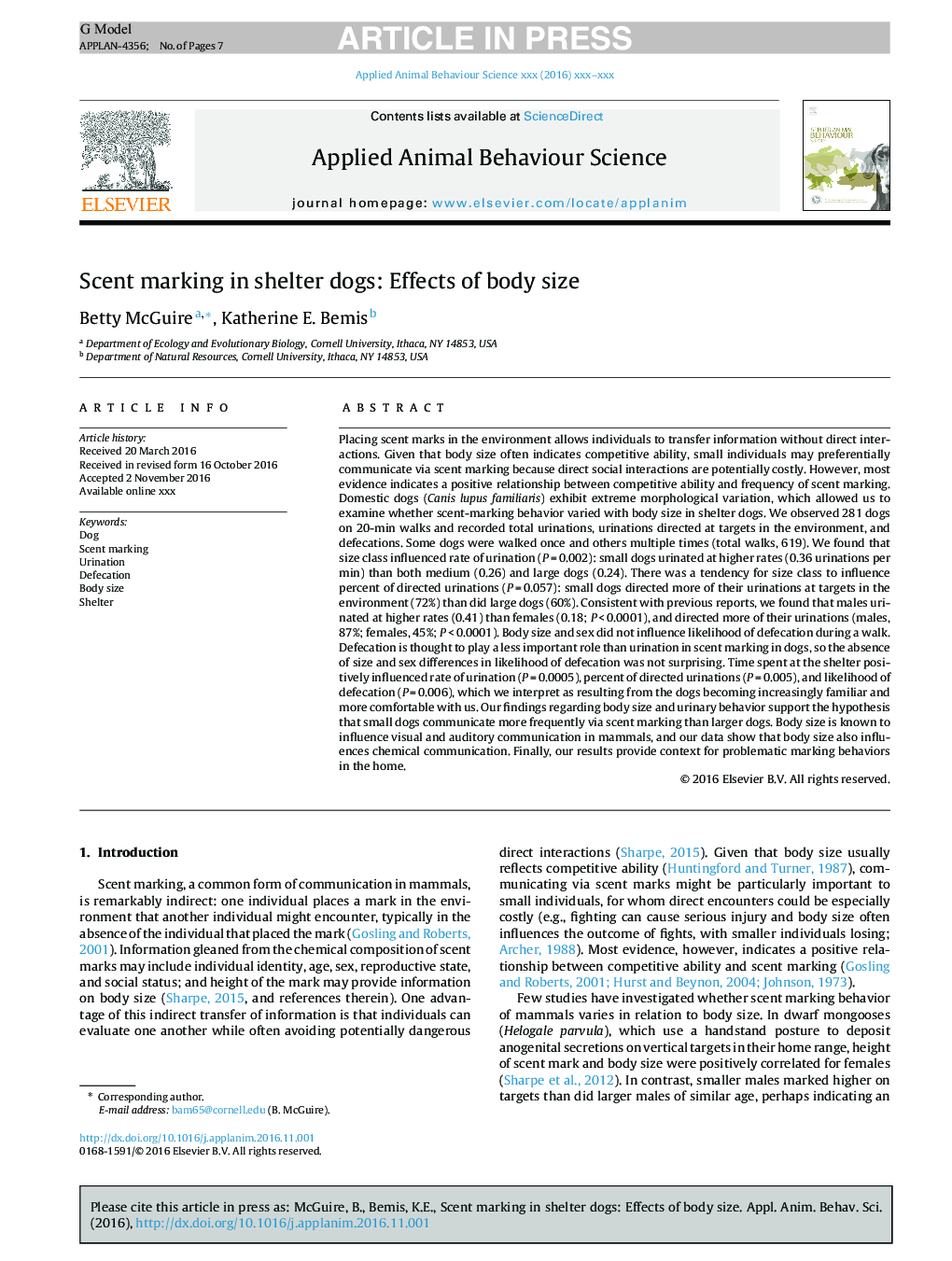| کد مقاله | کد نشریه | سال انتشار | مقاله انگلیسی | نسخه تمام متن |
|---|---|---|---|---|
| 5763383 | 1625320 | 2017 | 7 صفحه PDF | دانلود رایگان |
عنوان انگلیسی مقاله ISI
Scent marking in shelter dogs: Effects of body size
ترجمه فارسی عنوان
علامت گذاری عطر در سگهای پناهگاهی: اثرات اندازه بدن
دانلود مقاله + سفارش ترجمه
دانلود مقاله ISI انگلیسی
رایگان برای ایرانیان
کلمات کلیدی
سگ، علامت گذاری بو، ادرار کردن اشکال زدایی، اندازه بدن، پناه،
موضوعات مرتبط
علوم زیستی و بیوفناوری
علوم کشاورزی و بیولوژیک
علوم دامی و جانورشناسی
چکیده انگلیسی
Placing scent marks in the environment allows individuals to transfer information without direct interactions. Given that body size often indicates competitive ability, small individuals may preferentially communicate via scent marking because direct social interactions are potentially costly. However, most evidence indicates a positive relationship between competitive ability and frequency of scent marking. Domestic dogs (Canis lupus familiaris) exhibit extreme morphological variation, which allowed us to examine whether scent-marking behavior varied with body size in shelter dogs. We observed 281 dogs on 20-min walks and recorded total urinations, urinations directed at targets in the environment, and defecations. Some dogs were walked once and others multiple times (total walks, 619). We found that size class influenced rate of urination (PÂ =Â 0.002): small dogs urinated at higher rates (0.36 urinations per min) than both medium (0.26) and large dogs (0.24). There was a tendency for size class to influence percent of directed urinations (PÂ =Â 0.057): small dogs directed more of their urinations at targets in the environment (72%) than did large dogs (60%). Consistent with previous reports, we found that males urinated at higher rates (0.41) than females (0.18; PÂ <Â 0.0001), and directed more of their urinations (males, 87%; females, 45%; PÂ <Â 0.0001). Body size and sex did not influence likelihood of defecation during a walk. Defecation is thought to play a less important role than urination in scent marking in dogs, so the absence of size and sex differences in likelihood of defecation was not surprising. Time spent at the shelter positively influenced rate of urination (PÂ =Â 0.0005), percent of directed urinations (PÂ =Â 0.005), and likelihood of defecation (PÂ =Â 0.006), which we interpret as resulting from the dogs becoming increasingly familiar and more comfortable with us. Our findings regarding body size and urinary behavior support the hypothesis that small dogs communicate more frequently via scent marking than larger dogs. Body size is known to influence visual and auditory communication in mammals, and our data show that body size also influences chemical communication. Finally, our results provide context for problematic marking behaviors in the home.
ناشر
Database: Elsevier - ScienceDirect (ساینس دایرکت)
Journal: Applied Animal Behaviour Science - Volume 186, January 2017, Pages 49-55
Journal: Applied Animal Behaviour Science - Volume 186, January 2017, Pages 49-55
نویسندگان
Betty McGuire, Katherine E. Bemis,
